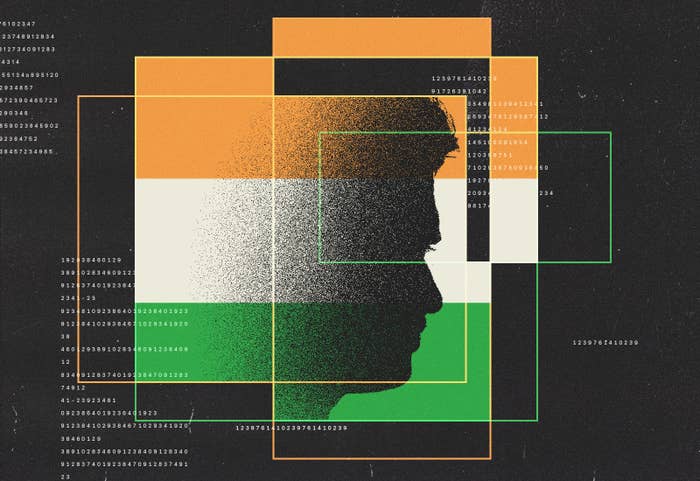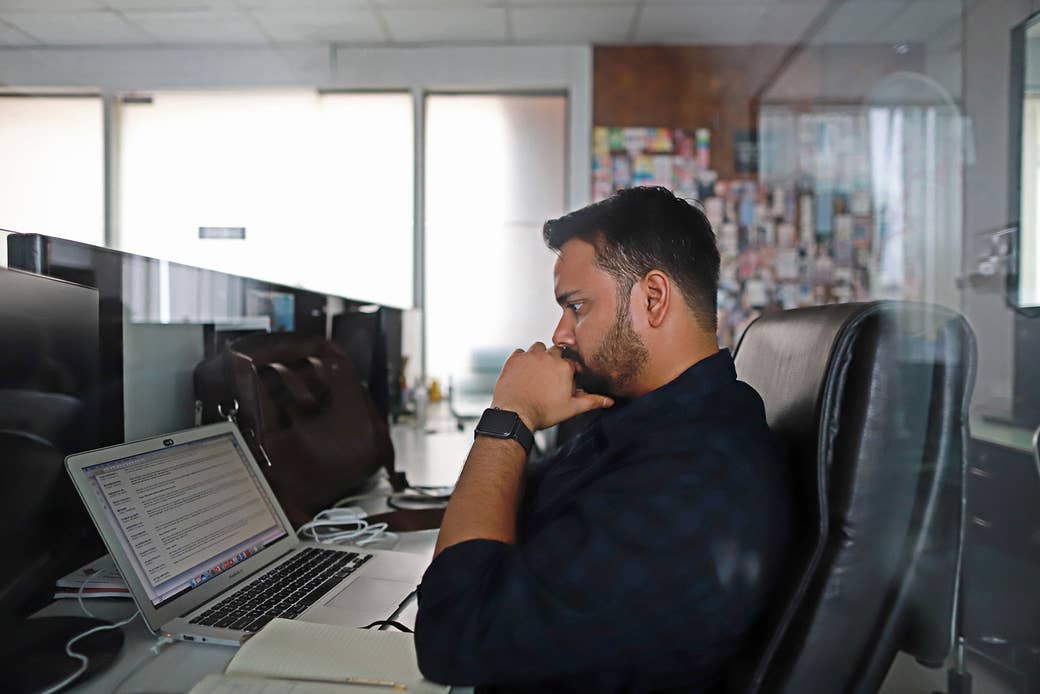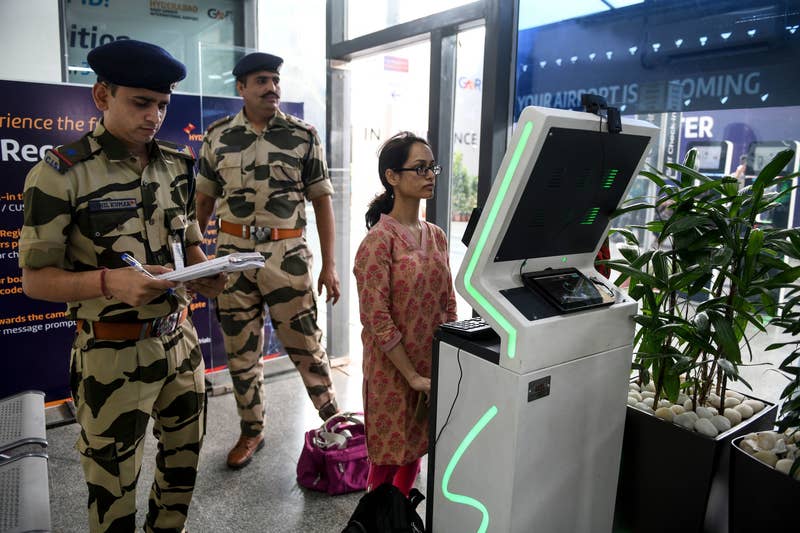https://www.buzzfeednews.com/articl...ting-a-national-facial-recognition-system-and
“Unless we all get plastic surgery at the same time, there’s nothing we can do about it.”
 Pranav Dixit BuzzFeed News Reporter
Pranav Dixit BuzzFeed News Reporter
Last updated on October 9, 2019, at 10:39 p.m. ET
Posted on October 9, 2019, at 7:01 p.m. ET

Ben Kothe / BuzzFeed News; Getty Images
Siddhant T. is a lawyer who is so concerned about his privacy that he wanted his name changed for this story. And so, when an airline representative at New Delhi’s Indira Gandhi airport suggested he check in with his face for a flight to Bangalore in September, he bristled — and then declined. The representative looked confused and called a befuddled supervisor, who repeated what his colleague had said.
“I just sort of looked at them in disbelief,” said Siddhant, “and then shuffled off immediately to check in the old-fashioned way.”
Later that day, he posted a picture of his boarding pass to his Instagram. “I was just told that I could use my face to print [my] boarding pass,” he wrote. “How the f do [they] have my biometric data? Are they permitted to use it for shyt like this?”
They are.
On Sept. 6, New Delhi’s Indira Gandhi airport became the fourth airport in India to test a facial recognition system to let passengers board by letting a machine scan their faces. The tech is scheduled to roll out at all the major airports in the country in the next few years. The government calls it “Digi Yatra” — Digital Journey — and it is a partnership between India’s federal aviation ministry and private companies. The aim, according to a 2018 government document, is to use biometric data — the curves of passengers’ faces, the tilts of their noses — to create a “digital travel experience.”
It isn’t just airports. Hundreds of Indian police stations, malls, and schools already use a patchwork of facial recognition systems powered by tech from dozens of private companies, and major cities have rushed to install hundreds of thousands of closed-circuit cameras on street corners.
And in the eyes of critics, each camera is another knot in this tightening mesh over India, in which facial recognition tech, a national biometric ID system, and weak data privacy laws are creating a surveillance state in a country ruled by a populist right-wing government.
The government of Prime Minister Narendra Modi, and his Bharatiya Janata Party, has surveillance ambitions to rival the most advanced in the world. India’s National Crime Records Bureau is in the midst of collecting bids from private companies to create the country’s first centralized facial recognition surveillance system. Once it’s up and running — the NCRB hasn’t specified a time frame for its launch — it will be linked with more than a dozen databases, although it is unclear at this point whether Aadhaar, India's biometric ID database that has drawn criticism for enabling nationwide surveillance on the country's 1.3 billion citizens, would be one of them.

Atul Loke / Getty Images
Narendra Modi speaks to the victorious party workers at the BJP party headquarters in New Delhi.
The rise of Modi’s BJP has been linked to an increase in violence against the country’s Muslim minorities, including 2002 riots that killed hundreds of people in Gujarat while Modi served as chief minister of the state. The pattern has repeated more recently. In September, when Modi visited Texas with US President Donald Trump, the Atlantic wrote that “mob lynchings in India [have] for many Muslims have come to symbolize their existence under a Hindu-nationalist regime.”
A crackdown in the state of Jammu and Kashmir has entered its third month, including a blackout of electronic communications and military-enforced curfews, after the national government rescinded the quasi-autonomous status the state had enjoyed for seven decades.
And last month, India’s government started building mass detention camps after telling nearly 2 million people in the northeastern state of Assam — mostly Muslims — that they could be stripped of their citizenship. Days later, Amit Shah, India’s home minister and Modi’s second-in-command, chaired a meeting to jump-start the National Intelligence Grid, a project that would link together stand-alone databases containing tax records, bank details, credit card transactions, air and train travel records, and more.
According to a bid document that the NCRB published, the objectives of the system are to “[modernize] the police force, information gathering, criminal identification, verification and its dissemination among various police organizations and units across the country.”
But critics say that the system could give India’s right-wing government new ways to clamp down on dissenters and minorities
“I think [the centralized facial recognition system] will fundamentally change how surveillance is carried out in India,” said Vidushi Marda, a lawyer and a research analyst at Carnegie India who studies how police across the country use facial recognition. “I know the [government’s] pitch is ‘safety,’ ‘security,’ and ‘crime prevention,’ but it’s actually a surveillance mechanism.” In fact, said Marda, facial recognition is more dangerous than Aadhaar: “Unless we all get plastic surgery at the same time, there’s nothing we can do about it.”
Even plastic surgery may not be a dramatic enough remedy to avoid surveillance once the system is up and running. According to the government’s bid document, it should be able to compensate for modifications made by plastic surgery, age, scars, tattoos, beards, makeup, and more. It should also be able to work with pictures published in newspapers and “sketches.” It should also be able to capture footage from CCTV cameras, as well as images from public or private video feeds, and “generate alerts if a blacklist match is found.”

Anindito Mukherjee / Bloomberg via Getty Images
Atul Rai, chief executive officer of Staqu Technologies, works on a laptop at the company's headquarters in Gurugram, Haryana, on Sept. 10.
For years, Indian police stations have kept records of suspects and criminals — demographic information, identifying markers, photographs, and more — in dusty cardboard files. They were rarely digitized, let alone easily searchable. And thousands of different criminal records siloed in police stations across the country meant in most cases that if a criminal crossed state lines, police in the new state wouldn’t already have a record of them.
In 2016, Atul Rai saw a market. “The idea was to take our existing technology and build upon it and get into the local homeland security market,” said Rai, the cofounder of Staqu Technologies which began as an image recognition and data analysis firm in Gurgaon, a satellite city near New Delhi. “America had Palantir. China had SenseTime. India didn’t have a single brand like that in this space. So we wanted to be that.”
“America had Palantir. China had SenseTime. India didn’t have a single brand like that in this space. So we wanted to be that.”
Staqu worked with police stations to digitize their existing criminal records, and created a system that would let cops use an Android smartphone to click a picture of people they arrest, and log their demographic data, voice samples, and fingerprints into a national, searchable database. Staqu’s system is now used by police stations in eight Indian states. Rai claims that there are over a million records in the database so far, and police officers across the country are adding 1,000 more to the system per day.
When he started, Rai had two problems unique to India: Most existing facial recognition systems were trained on Western face models, and their images were captured mostly from high-resolution CCTV. In contrast, most of India’s CCTV cameras, said Rai, were low resolution, and, unlike existing systems in the US, there were no standards for India’s diverse set of facial features.
So Rai set about training Staqu’s system from scratch. The team developed proprietary tech to make sure that accuracy levels were high, even with low-quality images. And it scraped facial data from publicly available sources like Google Images of more than a million Indian celebrities from both Bollywood movies and dozens of regionally produced films popular across India’s 29 states. “We trained our model on the Indian facial ecosystem,” Rai said. Doing this, he said, was crucial, since Indians from different parts of the country can often look markedly different from each other. Kashmiris in the north, for instance, are pale, while people from South Indian states have much darker skin. Sikh men usually have full beards and turbans.
Authoritarian regimes have used these kinds of physical differences for discrimination or worse through facial recognition. A New York Times report published earlier this year highlighted how the Chinese government uses a secret system of advanced facial recognition technology to track and control Uighurs in the western region of the country who look distinctly different from China’s majority Han population.
“Unless we all get plastic surgery at the same time, there’s nothing we can do about it.”
 Pranav Dixit BuzzFeed News Reporter
Pranav Dixit BuzzFeed News Reporter Last updated on October 9, 2019, at 10:39 p.m. ET
Posted on October 9, 2019, at 7:01 p.m. ET

Ben Kothe / BuzzFeed News; Getty Images
Siddhant T. is a lawyer who is so concerned about his privacy that he wanted his name changed for this story. And so, when an airline representative at New Delhi’s Indira Gandhi airport suggested he check in with his face for a flight to Bangalore in September, he bristled — and then declined. The representative looked confused and called a befuddled supervisor, who repeated what his colleague had said.
“I just sort of looked at them in disbelief,” said Siddhant, “and then shuffled off immediately to check in the old-fashioned way.”
Later that day, he posted a picture of his boarding pass to his Instagram. “I was just told that I could use my face to print [my] boarding pass,” he wrote. “How the f do [they] have my biometric data? Are they permitted to use it for shyt like this?”
They are.
On Sept. 6, New Delhi’s Indira Gandhi airport became the fourth airport in India to test a facial recognition system to let passengers board by letting a machine scan their faces. The tech is scheduled to roll out at all the major airports in the country in the next few years. The government calls it “Digi Yatra” — Digital Journey — and it is a partnership between India’s federal aviation ministry and private companies. The aim, according to a 2018 government document, is to use biometric data — the curves of passengers’ faces, the tilts of their noses — to create a “digital travel experience.”
It isn’t just airports. Hundreds of Indian police stations, malls, and schools already use a patchwork of facial recognition systems powered by tech from dozens of private companies, and major cities have rushed to install hundreds of thousands of closed-circuit cameras on street corners.
And in the eyes of critics, each camera is another knot in this tightening mesh over India, in which facial recognition tech, a national biometric ID system, and weak data privacy laws are creating a surveillance state in a country ruled by a populist right-wing government.
The government of Prime Minister Narendra Modi, and his Bharatiya Janata Party, has surveillance ambitions to rival the most advanced in the world. India’s National Crime Records Bureau is in the midst of collecting bids from private companies to create the country’s first centralized facial recognition surveillance system. Once it’s up and running — the NCRB hasn’t specified a time frame for its launch — it will be linked with more than a dozen databases, although it is unclear at this point whether Aadhaar, India's biometric ID database that has drawn criticism for enabling nationwide surveillance on the country's 1.3 billion citizens, would be one of them.

Atul Loke / Getty Images
Narendra Modi speaks to the victorious party workers at the BJP party headquarters in New Delhi.
The rise of Modi’s BJP has been linked to an increase in violence against the country’s Muslim minorities, including 2002 riots that killed hundreds of people in Gujarat while Modi served as chief minister of the state. The pattern has repeated more recently. In September, when Modi visited Texas with US President Donald Trump, the Atlantic wrote that “mob lynchings in India [have] for many Muslims have come to symbolize their existence under a Hindu-nationalist regime.”
A crackdown in the state of Jammu and Kashmir has entered its third month, including a blackout of electronic communications and military-enforced curfews, after the national government rescinded the quasi-autonomous status the state had enjoyed for seven decades.
And last month, India’s government started building mass detention camps after telling nearly 2 million people in the northeastern state of Assam — mostly Muslims — that they could be stripped of their citizenship. Days later, Amit Shah, India’s home minister and Modi’s second-in-command, chaired a meeting to jump-start the National Intelligence Grid, a project that would link together stand-alone databases containing tax records, bank details, credit card transactions, air and train travel records, and more.
According to a bid document that the NCRB published, the objectives of the system are to “[modernize] the police force, information gathering, criminal identification, verification and its dissemination among various police organizations and units across the country.”
But critics say that the system could give India’s right-wing government new ways to clamp down on dissenters and minorities
“I think [the centralized facial recognition system] will fundamentally change how surveillance is carried out in India,” said Vidushi Marda, a lawyer and a research analyst at Carnegie India who studies how police across the country use facial recognition. “I know the [government’s] pitch is ‘safety,’ ‘security,’ and ‘crime prevention,’ but it’s actually a surveillance mechanism.” In fact, said Marda, facial recognition is more dangerous than Aadhaar: “Unless we all get plastic surgery at the same time, there’s nothing we can do about it.”
Even plastic surgery may not be a dramatic enough remedy to avoid surveillance once the system is up and running. According to the government’s bid document, it should be able to compensate for modifications made by plastic surgery, age, scars, tattoos, beards, makeup, and more. It should also be able to work with pictures published in newspapers and “sketches.” It should also be able to capture footage from CCTV cameras, as well as images from public or private video feeds, and “generate alerts if a blacklist match is found.”

Anindito Mukherjee / Bloomberg via Getty Images
Atul Rai, chief executive officer of Staqu Technologies, works on a laptop at the company's headquarters in Gurugram, Haryana, on Sept. 10.
For years, Indian police stations have kept records of suspects and criminals — demographic information, identifying markers, photographs, and more — in dusty cardboard files. They were rarely digitized, let alone easily searchable. And thousands of different criminal records siloed in police stations across the country meant in most cases that if a criminal crossed state lines, police in the new state wouldn’t already have a record of them.
In 2016, Atul Rai saw a market. “The idea was to take our existing technology and build upon it and get into the local homeland security market,” said Rai, the cofounder of Staqu Technologies which began as an image recognition and data analysis firm in Gurgaon, a satellite city near New Delhi. “America had Palantir. China had SenseTime. India didn’t have a single brand like that in this space. So we wanted to be that.”
“America had Palantir. China had SenseTime. India didn’t have a single brand like that in this space. So we wanted to be that.”
Staqu worked with police stations to digitize their existing criminal records, and created a system that would let cops use an Android smartphone to click a picture of people they arrest, and log their demographic data, voice samples, and fingerprints into a national, searchable database. Staqu’s system is now used by police stations in eight Indian states. Rai claims that there are over a million records in the database so far, and police officers across the country are adding 1,000 more to the system per day.
When he started, Rai had two problems unique to India: Most existing facial recognition systems were trained on Western face models, and their images were captured mostly from high-resolution CCTV. In contrast, most of India’s CCTV cameras, said Rai, were low resolution, and, unlike existing systems in the US, there were no standards for India’s diverse set of facial features.
So Rai set about training Staqu’s system from scratch. The team developed proprietary tech to make sure that accuracy levels were high, even with low-quality images. And it scraped facial data from publicly available sources like Google Images of more than a million Indian celebrities from both Bollywood movies and dozens of regionally produced films popular across India’s 29 states. “We trained our model on the Indian facial ecosystem,” Rai said. Doing this, he said, was crucial, since Indians from different parts of the country can often look markedly different from each other. Kashmiris in the north, for instance, are pale, while people from South Indian states have much darker skin. Sikh men usually have full beards and turbans.
Authoritarian regimes have used these kinds of physical differences for discrimination or worse through facial recognition. A New York Times report published earlier this year highlighted how the Chinese government uses a secret system of advanced facial recognition technology to track and control Uighurs in the western region of the country who look distinctly different from China’s majority Han population.




